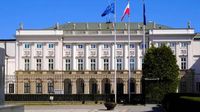As the presidential election in Poland approaches, a recent poll conducted by the Institute of Market Research and Social Research (IBRiS) for Polskie Radio 24 reveals a competitive race between candidates. If the election were held this Sunday, April 27, 2025, Rafał Trzaskowski, representing the Civic Coalition, would lead with 33.2% of the votes, while Karol Nawrocki, backed by the ruling Law and Justice party (PiS), would follow with 25.6%. Sławomir Mentzen, representing the Confederation, would secure 11.5% of the vote.
The poll results indicate that Trzaskowski is well-positioned to advance to the second round of voting, which is scheduled for June 1, 2025, should no candidate achieve the required 50% majority in the first round on May 18, 2025. The other candidates in the running, based on their projected support, include Szymon Hołownia with 6.1%, Magdalena Biejat at 5.1%, and Adrian Zandberg with 3.2%. The remaining candidates received less than 2% each, with Marek Jakubiak at 1.6%, Grzegorz Braun at 1.4%, Joanna Senyszyn at 1.2%, Krzysztof Stanowski at 1.1%, Artur Bartoszewicz at 0.2%, and both Maciej Maciak and Marek Woch at 0.0%. Notably, 9.8% of respondents were undecided, answering "I don’t know/hard to say."
In terms of voter turnout, the poll suggests a strong engagement among the electorate. When asked if they would participate in the election, 38.8% of respondents stated they would "definitely" vote, while 15.5% indicated they would "probably" vote. However, a significant portion of the population remains hesitant, with 28.1% stating they would "definitely not" participate and 15.3% saying "probably not." Only 2.3% remained uncertain.
The IBRiS poll was conducted between April 25 and April 26, 2025, using the CATI method on a representative sample of 1,070 individuals from across Poland. This survey reflects the current political landscape and the shifting sentiments among Polish voters as the election date approaches.
Trzaskowski's lead in the polls is significant, especially as he prepares to face Nawrocki in what is anticipated to be a closely watched second round. The Civic Coalition candidate has been actively campaigning, focusing on issues that resonate with the electorate, including economic stability and social justice. His ability to maintain this lead will be crucial in the coming weeks as the election draws nearer.
On the other hand, Nawrocki, as the PiS candidate, is expected to leverage the party’s established support base. His campaign is likely to focus on continuing the policies that have characterized PiS's governance, including national security and economic growth. The dynamics between these two candidates will undoubtedly shape the discourse leading up to the election.
The upcoming election is particularly notable not only for the candidates involved but also for the broader implications it holds for Poland’s political future. As the nation grapples with various challenges, including economic recovery post-COVID-19 and socio-political tensions, the outcome of this election could have lasting effects on the country’s direction.
As voters prepare to make their choices, the importance of informed decision-making cannot be overstated. With a diverse array of candidates and perspectives, the Polish electorate has the opportunity to shape their future significantly.
In summary, the latest IBRiS poll indicates a competitive race for the presidency, with Trzaskowski currently in the lead. Voter turnout will be a critical factor in determining the outcome, and as the election date approaches, both candidates will need to intensify their efforts to sway undecided voters. The political landscape in Poland is poised for a dramatic shift, and all eyes will be on the results of the May 18 election.






